FORD E SERIES 2013 4.G Workshop Manual
Manufacturer: FORD, Model Year: 2013, Model line: E SERIES, Model: FORD E SERIES 2013 4.GPages: 416, PDF Size: 4.29 MB
Page 51 of 416
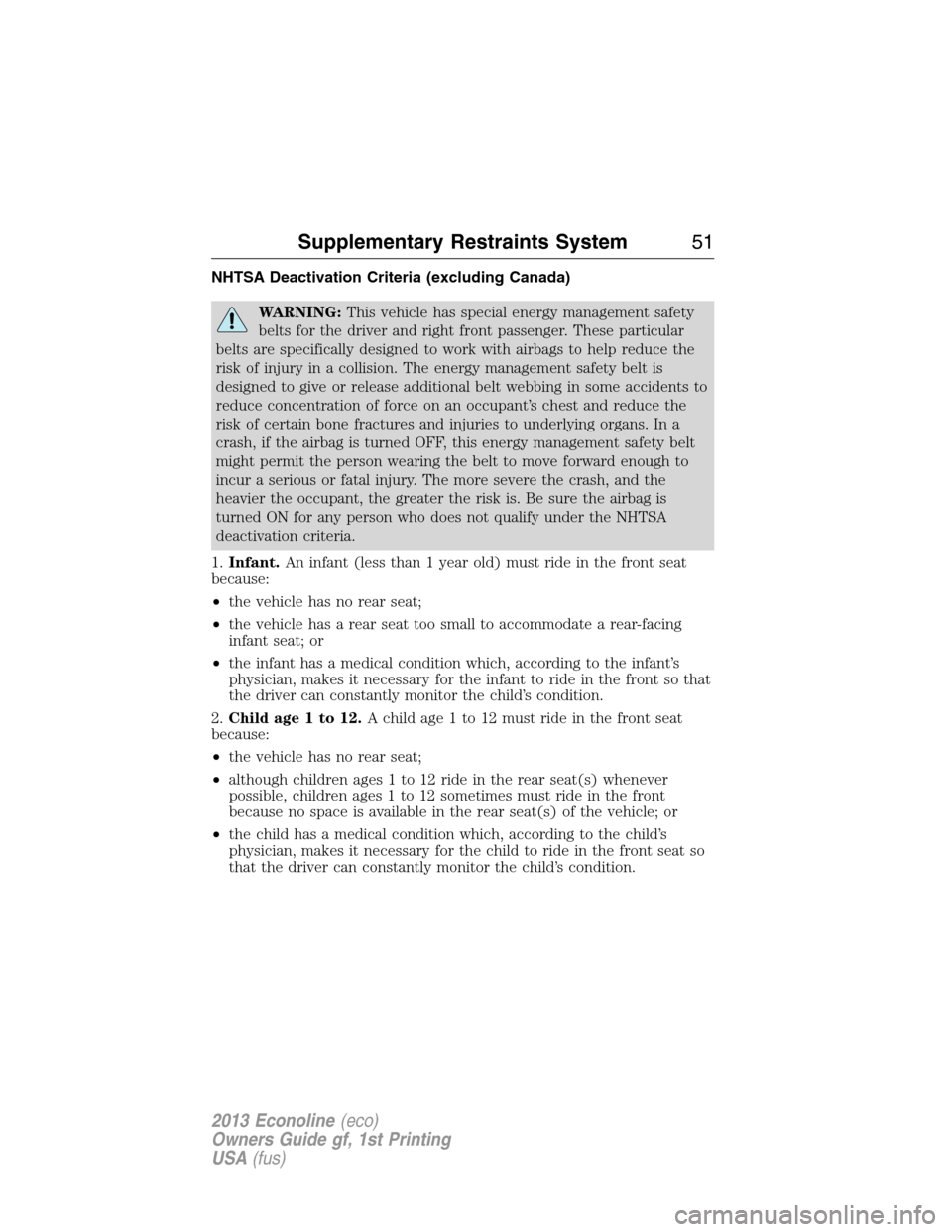
NHTSA Deactivation Criteria (excluding Canada)
WARNING:This vehicle has special energy management safety
belts for the driver and right front passenger. These particular
belts are specifically designed to work with airbags to help reduce the
risk of injury in a collision. The energy management safety belt is
designed to give or release additional belt webbing in some accidents to
reduce concentration of force on an occupant’s chest and reduce the
risk of certain bone fractures and injuries to underlying organs. In a
crash, if the airbag is turned OFF, this energy management safety belt
might permit the person wearing the belt to move forward enough to
incur a serious or fatal injury. The more severe the crash, and the
heavier the occupant, the greater the risk is. Be sure the airbag is
turned ON for any person who does not qualify under the NHTSA
deactivation criteria.
1.Infant.An infant (less than 1 year old) must ride in the front seat
because:
•the vehicle has no rear seat;
•the vehicle has a rear seat too small to accommodate a rear-facing
infant seat; or
•the infant has a medical condition which, according to the infant’s
physician, makes it necessary for the infant to ride in the front so that
the driver can constantly monitor the child’s condition.
2.Child age 1 to 12.A child age 1 to 12 must ride in the front seat
because:
•the vehicle has no rear seat;
•although children ages 1 to 12 ride in the rear seat(s) whenever
possible, children ages 1 to 12 sometimes must ride in the front
because no space is available in the rear seat(s) of the vehicle; or
•the child has a medical condition which, according to the child’s
physician, makes it necessary for the child to ride in the front seat so
that the driver can constantly monitor the child’s condition.
Supplementary Restraints System51
2013 Econoline(eco)
Owners Guide gf, 1st Printing
USA(fus)
Page 52 of 416

3.Medical condition.A passenger has a medical condition which,
according to his or her physician:
•causes the passenger airbag to pose a special risk for the passenger;
and
•makes the potential harm from the passenger airbag in a crash greater
than the potential harm from turning OFF the airbag and allowing the
passenger, even if belted, to hit the dashboard or windshield in a
crash.
Transport Canada Deactivation Criteria (Canada Only)
WARNING:This vehicle has special energy management safety
belts for the driver and right front passenger. These particular
belts are specifically designed to work with airbags to help reduce the
risk of injury in a collision. The energy management safety belt is
designed to give or release additional belt webbing in some accidents to
reduce concentration of force on an occupant’s chest and reduce the
risk of certain bone fractures and injuries to underlying organs. In a
crash, if the airbag is turned OFF, this energy management safety belt
might permit the person wearing the belt to move forward enough to
incur a serious or fatal injury. The more severe the crash, and the
heavier the occupant, the greater the risk is. Be sure the airbag is
turned ON for any person who does not qualify under the NHTSA
deactivation criteria.
1.Infant:An infant (less than 1 year old) must ride in the front seat
because:
•my vehicle has no rear seat;
•the rear seat in my vehicle cannot accommodate a rear-facing infant
seat; or
•the infant has a medical condition which, according to the infant’s
physician, makes it necessary for the infant to ride in the front seat so
that the driver can monitor the infant’s condition.
52Supplementary Restraints System
2013 Econoline(eco)
Owners Guide gf, 1st Printing
USA(fus)
Page 53 of 416

2.Child age 12 or under:A child age 12 or under must ride in the
front seat because:
•my vehicle has no rear seat;
•although children age 12 and under ride in the rear seat whenever
possible, children age 12 and under have no option but to sometimes
ride in the front seat because rear seat space is insufficient; or
•the child has a medical condition that, according to the child’s
physician, makes it necessary for the child to ride in the front seat so
that the driver can monitor the child’s condition.
3.Medical condition:A passenger has a medical condition that,
according to his or her physician:
•poses a special risk for the passenger if the airbag deploys; and
•makes the potential harm from the passenger airbag deployment
greater than the potential harm from turning OFF the airbag and
experiencing a crash without the protection offered by the airbag
CRASH SENSORS AND AIRBAG INDICATOR
WARNING:Modifying or adding equipment to the front end of
your vehicle (including frame, bumper, front end body structure
and tow hooks) may affect the performance of the airbag system,
increasing the risk of injury. Do not modify the front end of your
vehicle.
Your vehicle has a collection of crash and occupant sensors which
provide information to the Restraints Control Module (RCM) which
deploys (activates) the front safety belt pretensioners, driver airbag and
passenger airbag. Based on the type of accident, the restraints control
module will deploy the appropriate safety devices.
The restraints control module also monitors the readiness of the above
safety devices plus the crash and occupant sensors. The readiness of the
safety system is indicated by a warning indicator light in the instrument
cluster or by a backup tone if the warning light is not working. See
Warning lamps and indicatorsin theInstrument Clusterchapter.
Routine maintenance of the airbag is not required.
Supplementary Restraints System53
2013 Econoline(eco)
Owners Guide gf, 1st Printing
USA(fus)
Page 54 of 416
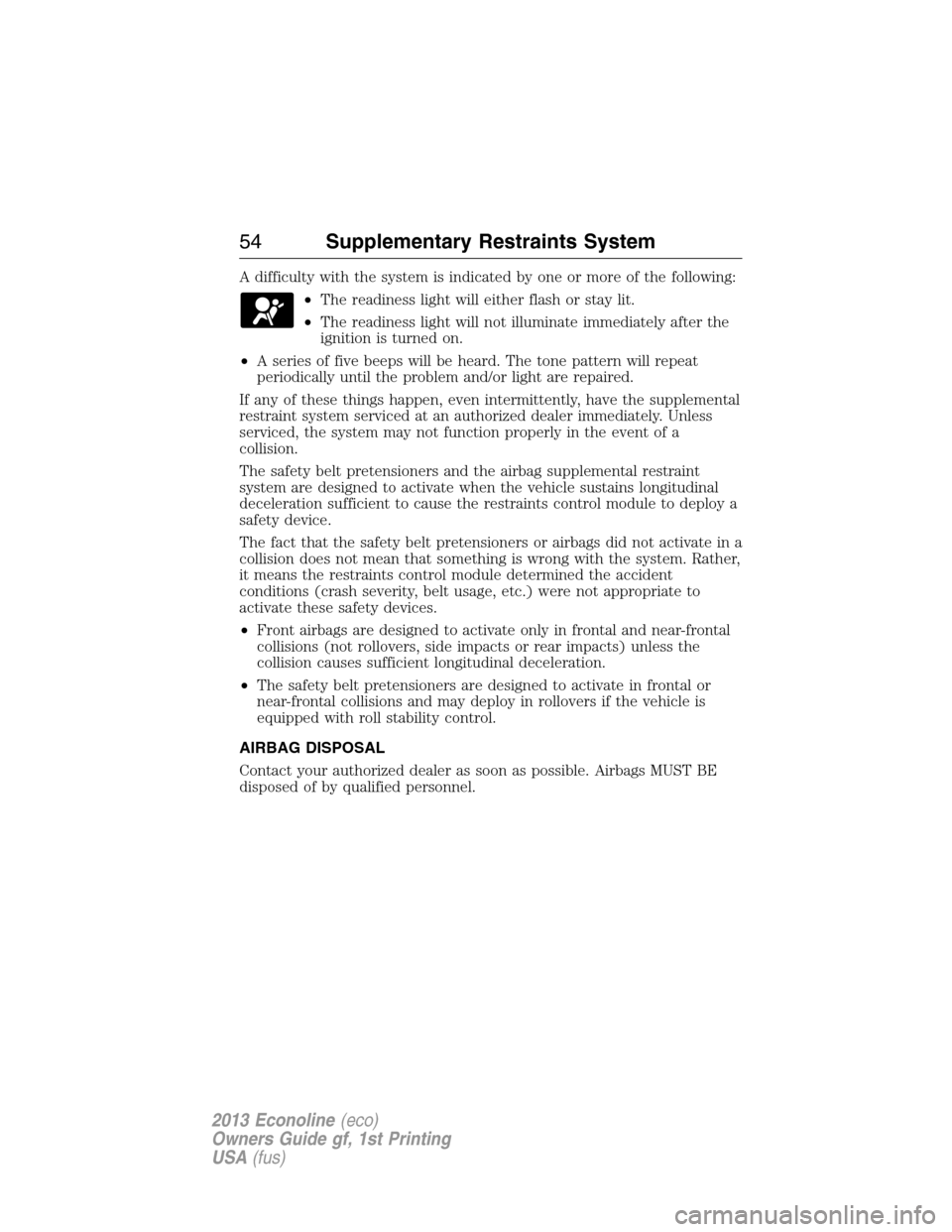
A difficulty with the system is indicated by one or more of the following:
•The readiness light will either flash or stay lit.
•The readiness light will not illuminate immediately after the
ignition is turned on.
•A series of five beeps will be heard. The tone pattern will repeat
periodically until the problem and/or light are repaired.
If any of these things happen, even intermittently, have the supplemental
restraint system serviced at an authorized dealer immediately. Unless
serviced, the system may not function properly in the event of a
collision.
The safety belt pretensioners and the airbag supplemental restraint
system are designed to activate when the vehicle sustains longitudinal
deceleration sufficient to cause the restraints control module to deploy a
safety device.
The fact that the safety belt pretensioners or airbags did not activate in a
collision does not mean that something is wrong with the system. Rather,
it means the restraints control module determined the accident
conditions (crash severity, belt usage, etc.) were not appropriate to
activate these safety devices.
•Front airbags are designed to activate only in frontal and near-frontal
collisions (not rollovers, side impacts or rear impacts) unless the
collision causes sufficient longitudinal deceleration.
•The safety belt pretensioners are designed to activate in frontal or
near-frontal collisions and may deploy in rollovers if the vehicle is
equipped with roll stability control.
AIRBAG DISPOSAL
Contact your authorized dealer as soon as possible. Airbags MUST BE
disposed of by qualified personnel.
54Supplementary Restraints System
2013 Econoline(eco)
Owners Guide gf, 1st Printing
USA(fus)
Page 55 of 416

GENERAL INFORMATION ON RADIO FREQUENCIES
This device complies with part 15 of the FCC Rules and with Industry
Canada license-exempt RSS standard(s). Operation is subject to the
following two conditions: (1) This device may not cause harmful
interference, and (2) This device must accept any interference received,
including interference that may cause undesired operation.
Note:Changes or modifications not expressly approved by the party
responsible for compliance could void the user’s authority to operate the
equipment. The termICbefore the radio certification number only
signifies that Industry Canada technical specifications were met.
The typical operating range for your transmitter is approximately 33 feet
(10 meters). Vehicles with the remote start feature will have a greater
range. A decrease in operating range could be caused by:
•weather conditions
•nearby radio towers
•structures around your vehicle
•other vehicles parked next to your vehicle.
The radio frequency used by your remote control can also be used by
other short distance radio transmissions (e.g. amateur radios, medical
equipment, wireless headphones, remote controls and alarm systems). If
the frequencies are jammed, you will not be able to use your remote
control. You can lock and unlock the doors with the key.
Note:Make sure your vehicle is locked before leaving it unattended.
Note:If you are in range, the remote control will operate if you press
any button unintentionally.
REMOTE CONTROL (IF EQUIPPED)
If there are problems with the
remote entry system, make sure to
take all remote entry transmitters
with you to the authorized dealer in
order to aid in troubleshooting the
problem.
Note:If the vehicle is equipped
with the E-Guard Cargo Protection
System™ the remote transmitter unlock command will only unlock the
front doors. The only way to unlock the side or rear cargo doors from
outside the vehicle is with the key.
Keys and Remote Control55
2013 Econoline(eco)
Owners Guide gf, 1st Printing
USA(fus)
Page 56 of 416
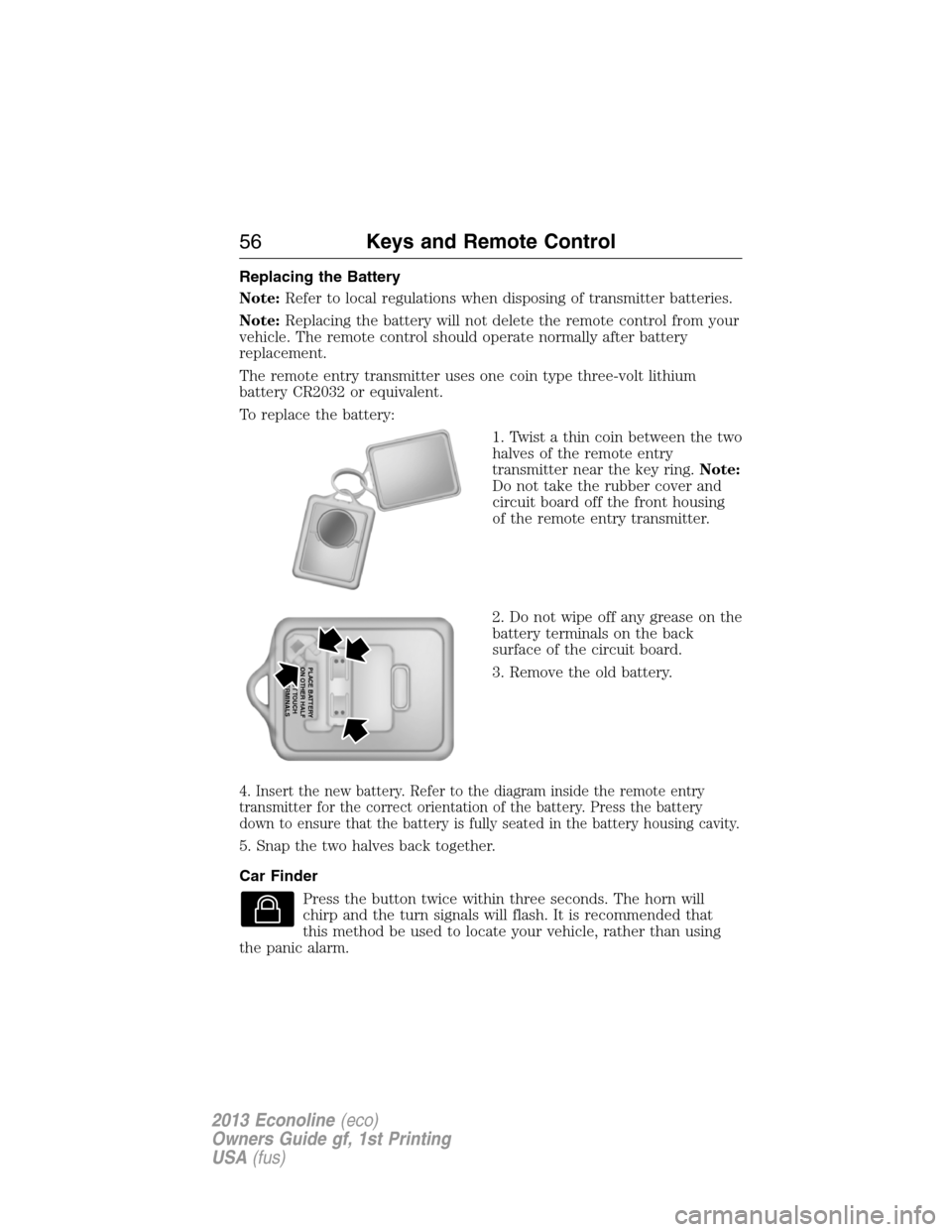
Replacing the Battery
Note:Refer to local regulations when disposing of transmitter batteries.
Note:Replacing the battery will not delete the remote control from your
vehicle. The remote control should operate normally after battery
replacement.
The remote entry transmitter uses one coin type three-volt lithium
battery CR2032 or equivalent.
To replace the battery:
1. Twist a thin coin between the two
halves of the remote entry
transmitter near the key ring.Note:
Do not take the rubber cover and
circuit board off the front housing
of the remote entry transmitter.
2. Do not wipe off any grease on the
battery terminals on the back
surface of the circuit board.
3. Remove the old battery.
4. Insert the new battery. Refer to the diagram inside the remote entry
transmitter for the correct orientation of the battery. Press the battery
down to ensure that the battery is fully seated in the battery housing cavity.
5. Snap the two halves back together.
Car Finder
Press the button twice within three seconds. The horn will
chirp and the turn signals will flash. It is recommended that
this method be used to locate your vehicle, rather than using
the panic alarm.
PLACE BATTERY
ON OTHER HALF
DO NOT TOUCH
THE TERMINALS
56Keys and Remote Control
2013 Econoline(eco)
Owners Guide gf, 1st Printing
USA(fus)
Page 57 of 416
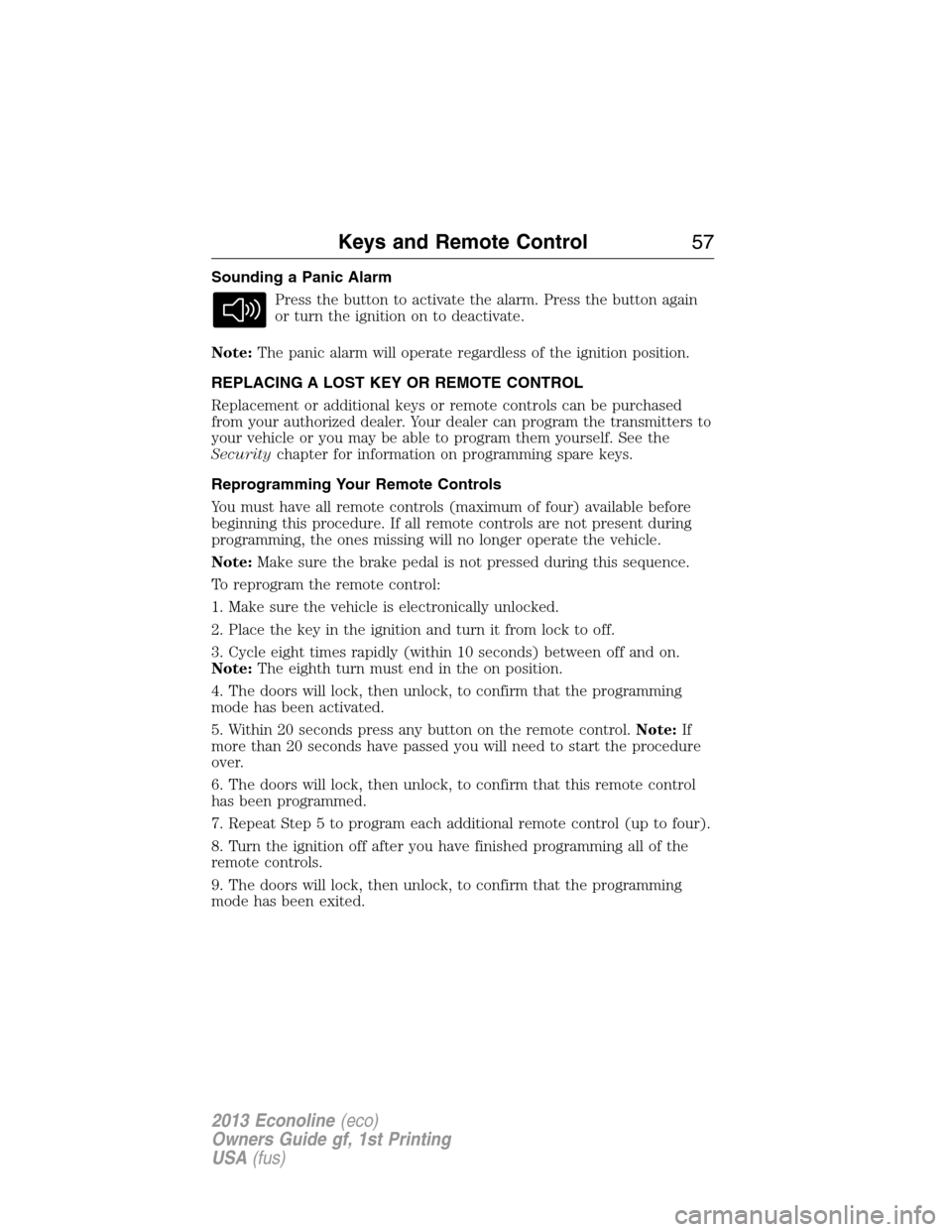
Sounding a Panic Alarm
Press the button to activate the alarm. Press the button again
or turn the ignition on to deactivate.
Note:The panic alarm will operate regardless of the ignition position.
REPLACING A LOST KEY OR REMOTE CONTROL
Replacement or additional keys or remote controls can be purchased
from your authorized dealer. Your dealer can program the transmitters to
your vehicle or you may be able to program them yourself. See the
Securitychapter for information on programming spare keys.
Reprogramming Your Remote Controls
You must have all remote controls (maximum of four) available before
beginning this procedure. If all remote controls are not present during
programming, the ones missing will no longer operate the vehicle.
Note:Make sure the brake pedal is not pressed during this sequence.
To reprogram the remote control:
1. Make sure the vehicle is electronically unlocked.
2. Place the key in the ignition and turn it from lock to off.
3. Cycle eight times rapidly (within 10 seconds) between off and on.
Note:The eighth turn must end in the on position.
4. The doors will lock, then unlock, to confirm that the programming
mode has been activated.
5. Within 20 seconds press any button on the remote control.Note:If
more than 20 seconds have passed you will need to start the procedure
over.
6. The doors will lock, then unlock, to confirm that this remote control
has been programmed.
7. Repeat Step 5 to program each additional remote control (up to four).
8. Turn the ignition off after you have finished programming all of the
remote controls.
9. The doors will lock, then unlock, to confirm that the programming
mode has been exited.
Keys and Remote Control57
2013 Econoline(eco)
Owners Guide gf, 1st Printing
USA(fus)
Page 58 of 416
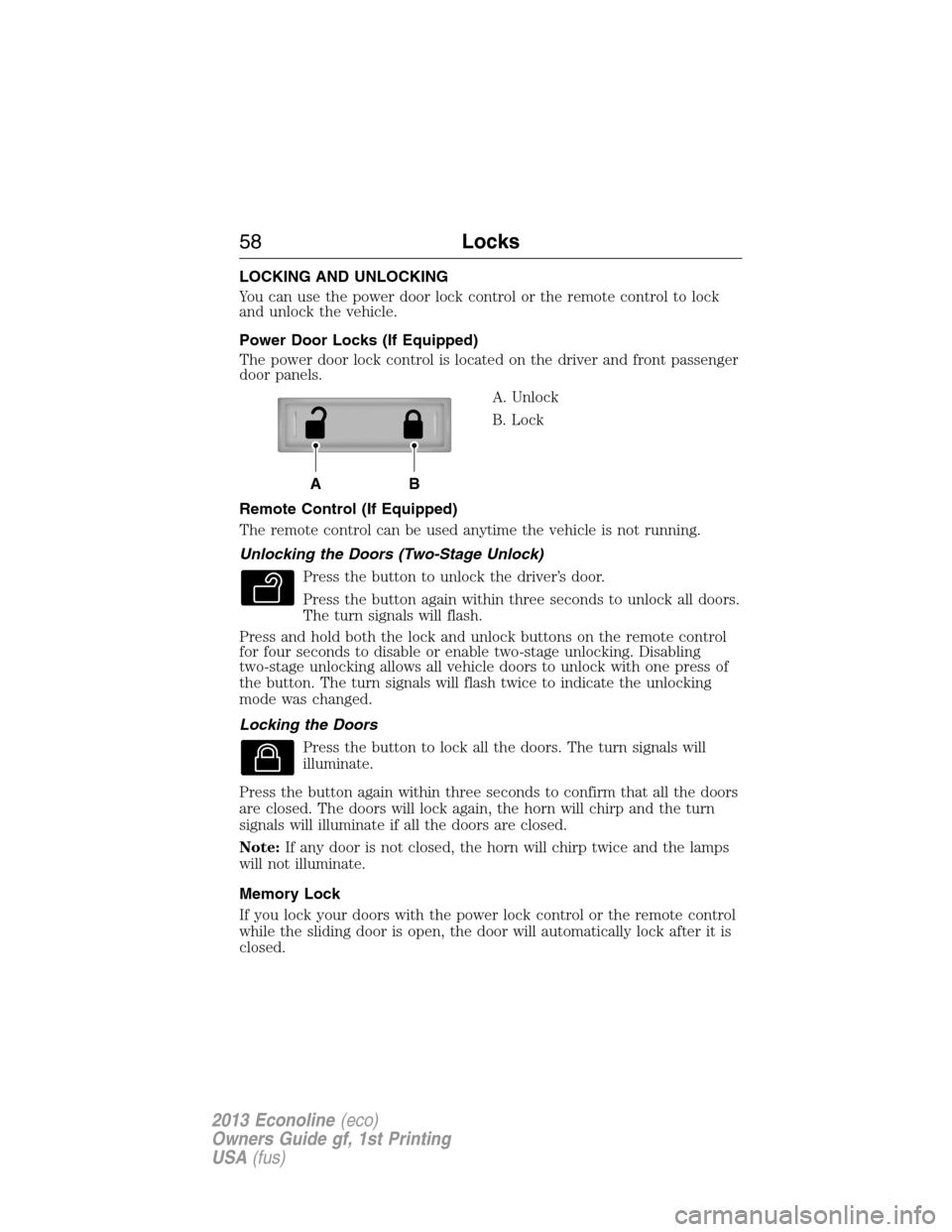
LOCKING AND UNLOCKING
You can use the power door lock control or the remote control to lock
and unlock the vehicle.
Power Door Locks (If Equipped)
The power door lock control is located on the driver and front passenger
door panels.
A. Unlock
B. Lock
Remote Control (If Equipped)
The remote control can be used anytime the vehicle is not running.
Unlocking the Doors (Two-Stage Unlock)
Press the button to unlock the driver’s door.
Press the button again within three seconds to unlock all doors.
The turn signals will flash.
Press and hold both the lock and unlock buttons on the remote control
for four seconds to disable or enable two-stage unlocking. Disabling
two-stage unlocking allows all vehicle doors to unlock with one press of
the button. The turn signals will flash twice to indicate the unlocking
mode was changed.
Locking the Doors
Press the button to lock all the doors. The turn signals will
illuminate.
Press the button again within three seconds to confirm that all the doors
are closed. The doors will lock again, the horn will chirp and the turn
signals will illuminate if all the doors are closed.
Note:If any door is not closed, the horn will chirp twice and the lamps
will not illuminate.
Memory Lock
If you lock your doors with the power lock control or the remote control
while the sliding door is open, the door will automatically lock after it is
closed.
AB
58Locks
2013 Econoline(eco)
Owners Guide gf, 1st Printing
USA(fus)
Page 59 of 416
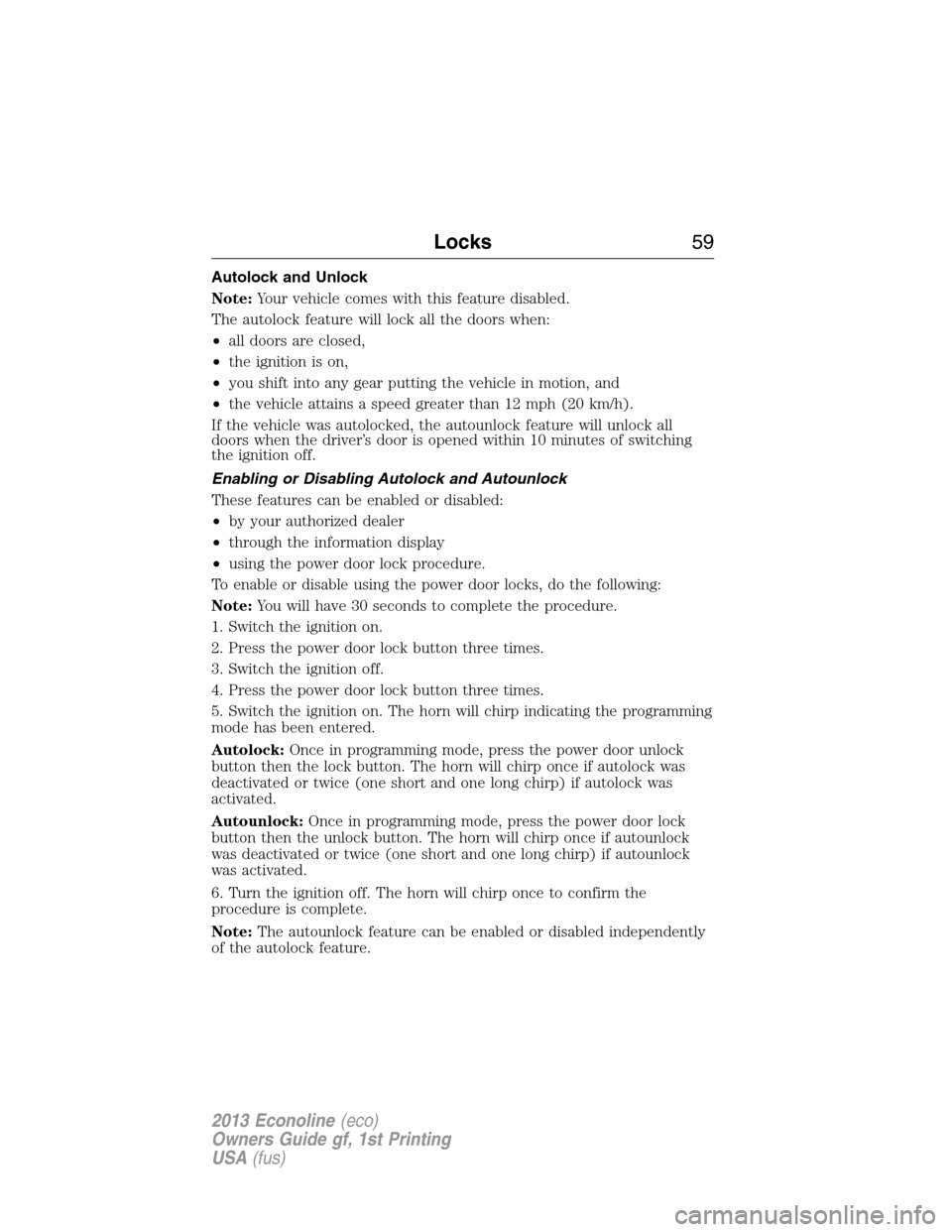
Autolock and Unlock
Note:Your vehicle comes with this feature disabled.
The autolock feature will lock all the doors when:
•all doors are closed,
•the ignition is on,
•you shift into any gear putting the vehicle in motion, and
•the vehicle attains a speed greater than 12 mph (20 km/h).
If the vehicle was autolocked, the autounlock feature will unlock all
doors when the driver’s door is opened within 10 minutes of switching
the ignition off.
Enabling or Disabling Autolock and Autounlock
These features can be enabled or disabled:
•by your authorized dealer
•through the information display
•using the power door lock procedure.
To enable or disable using the power door locks, do the following:
Note:You will have 30 seconds to complete the procedure.
1. Switch the ignition on.
2. Press the power door lock button three times.
3. Switch the ignition off.
4. Press the power door lock button three times.
5. Switch the ignition on. The horn will chirp indicating the programming
mode has been entered.
Autolock:Once in programming mode, press the power door unlock
button then the lock button. The horn will chirp once if autolock was
deactivated or twice (one short and one long chirp) if autolock was
activated.
Autounlock:Once in programming mode, press the power door lock
button then the unlock button. The horn will chirp once if autounlock
was deactivated or twice (one short and one long chirp) if autounlock
was activated.
6. Turn the ignition off. The horn will chirp once to confirm the
procedure is complete.
Note:The autounlock feature can be enabled or disabled independently
of the autolock feature.
Locks59
2013 Econoline(eco)
Owners Guide gf, 1st Printing
USA(fus)
Page 60 of 416
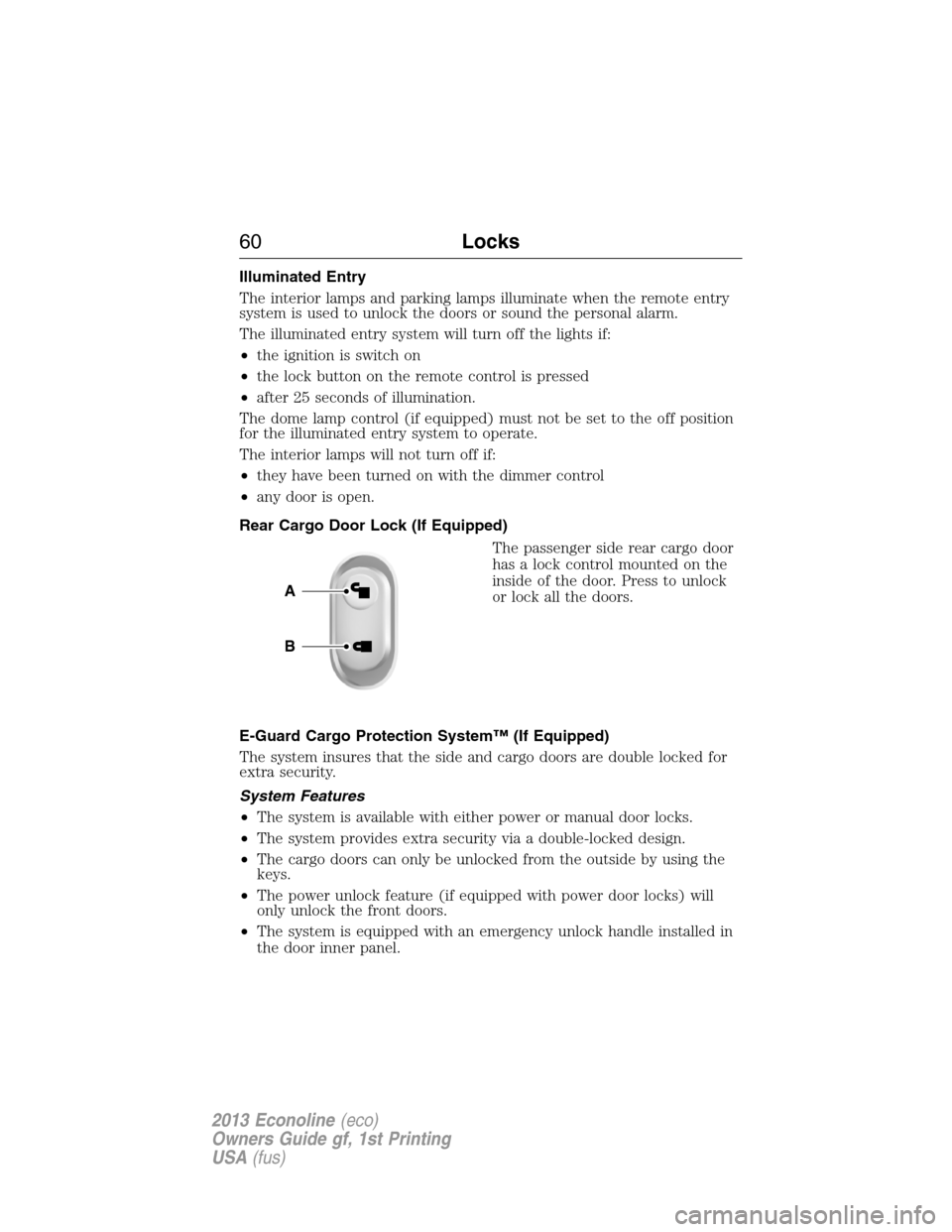
Illuminated Entry
The interior lamps and parking lamps illuminate when the remote entry
system is used to unlock the doors or sound the personal alarm.
The illuminated entry system will turn off the lights if:
•the ignition is switch on
•the lock button on the remote control is pressed
•after 25 seconds of illumination.
The dome lamp control (if equipped) must not be set to the off position
for the illuminated entry system to operate.
The interior lamps will not turn off if:
•they have been turned on with the dimmer control
•any door is open.
Rear Cargo Door Lock (If Equipped)
The passenger side rear cargo door
has a lock control mounted on the
inside of the door. Press to unlock
or lock all the doors.
E-Guard Cargo Protection System™ (If Equipped)
The system insures that the side and cargo doors are double locked for
extra security.
System Features
•The system is available with either power or manual door locks.
•The system provides extra security via a double-locked design.
•The cargo doors can only be unlocked from the outside by using the
keys.
•The power unlock feature (if equipped with power door locks) will
only unlock the front doors.
•The system is equipped with an emergency unlock handle installed in
the door inner panel.
A
B
60Locks
2013 Econoline(eco)
Owners Guide gf, 1st Printing
USA(fus)